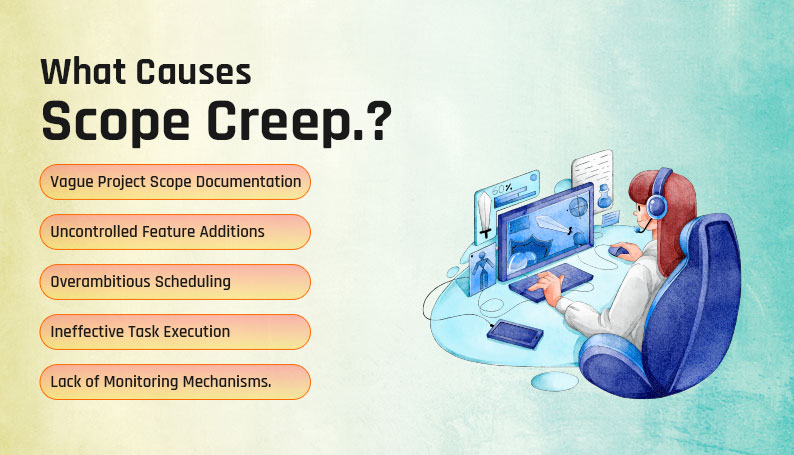Table of Contents
Avoiding scope creep in game development is essential for delivering projects on time and within budget. In full-cycle game projects, unchecked changes can derail timelines, inflate costs, and strain resources. In this brief guide by Juego Studios, let’s explore practical strategies and proven techniques to help studios maintain clarity, control, and creative focus throughout the development process.
In full-cycle game projects, scope creep occurs when unplanned features, mechanics, or changes are introduced after development has begun, without proper evaluation or scope control. These additions can affect timelines, resource planning, budgets, and milestone completion, making delivery unpredictable. Full-cycle game development challenges often arise from vague initial requirements or frequent stakeholder inputs. If unmanaged, scope creep can overwhelm the development team, leading to rushed outputs, technical debt, and diluted game quality. This issue is particularly common in complex projects where creative direction evolves mid-way, but processes like structured change requests and milestone tracking are essential to minimize risk and maintain clarity.
Managing scope in game projects is really hard, scope creep can severely derail planned timelines, inflate budgets, and compromise overall game quality. As new features or changes are added without proper evaluation, development teams are forced to stretch limited resources and timelines, often leading to rushed production or delays. Budgets escalate as additional work demands more hours, tools, or hires not accounted for in the original plan. Quality also suffers, testing becomes rushed, bugs slip through, and the gameplay experience may feel inconsistent. To ensure successful outcomes, managing scope tightly from pre-production through Live Games is essential in any full-cycle game development process.
 Top Causes of Scope Creep in Game Development
Top Causes of Scope Creep in Game Development
An unclear or incomplete project scope can lead to misaligned expectations and uncontrolled feature additions. Implementing game project management best practices ensures that objectives, timelines, and deliverables are well-defined, minimizing the risk of scope creep.
Introducing new features without a structured change control process can derail timelines and budgets. Establishing robust scope creep prevention for game studios involves formalizing change requests and assessing their impact before implementation.
Setting unrealistic deadlines without accounting for potential challenges can cause delays and budget overruns. Leveraging professional game development services aids in creating feasible schedules that accommodate the project’s complexity and resource availability.
Poorly executed tasks due to inadequate planning or communication can necessitate rework, expanding the project’s scope. Utilizing comprehensive game QA services ensures that issues are identified and addressed promptly, maintaining project alignment.
Without proper monitoring tools, deviations from the original scope can go unnoticed. Implementing regular reviews and employing project management software helps in early detection and correction of scope deviations.
By addressing these common causes with targeted strategies and professional services, game studios can effectively manage scope creep and ensure the successful completion of full-cycle game projects.
Feature creep often clutters UI with unnecessary elements, confusing users and breaking gameplay flow. Prioritizing simplicity during concept stages is key to managing scope in game projects and preserving a coherent player experience.
When too many features distract from core functionality, players disengage. Avoid over-engineering by focusing only on must-haves and understanding the game design documentation importance in maintaining focus throughout the development pipeline.
Overloaded interfaces and inconsistent mechanics from unchecked features lead to poor UX. Streamlining design and maintaining clarity helps ensure the experience remains enjoyable and intuitive, not frustrating or exhausting for your players.
Feature creep strains budgets and time, affecting internal costs and client satisfaction. Unplanned additions stretch development, increase resource demand, and contribute heavily to full-cycle game development challenges, impacting timelines and profitability.
 Scope Creep Consequences in Full-Cycle Development
Scope Creep Consequences in Full-Cycle Development
Establishing a well-structured Game Design Document (GDD) is crucial. It ensures all team members align on the game’s vision, mechanics, and goals, emphasizing the game design documentation importance in preventing miscommunication and scope creep.
Implementing robust project management tools streamlines task allocation and progress tracking. This approach not only enhances efficiency but also aids in scope creep prevention for game studios, ensuring projects stay within defined boundaries.
Employing prioritization frameworks like MoSCoW or RICE helps in distinguishing essential features from optional ones. This strategy aligns with game project management best practices, ensuring focus remains on core gameplay elements.
Regular updates and open dialogues with stakeholders foster trust and clarity. Such transparency is vital in avoiding scope creep in game development, as it manages expectations and reduces last-minute changes.
Acknowledging potential delays and incorporating buffer periods into schedules is prudent. This foresight is especially important when you hire game developers, as it accommodates unforeseen challenges without compromising quality.
While iteration is essential for refinement, it’s important to set boundaries. Controlled iteration ensures creativity thrives without derailing timelines, a balance that’s key in game development services.
Regular progress assessments help in early detection of deviations. Integrating game quality services into this process ensures that quality standards are met consistently throughout development.
Cultivating a culture that values quality over quantity is essential. Encouraging teams to concentrate on core objectives minimizes distractions, aligning with game project management best practices to deliver polished final products.
Game studios today leverage tools like Jira, Trello, and Codecks to define deliverables, monitor milestones, and visualize workflows. These platforms help developers track task dependencies, assign responsibilities, and detect scope shifts early, maintaining clarity from concept to launch.
Agile methodologies, including Scrum and Kanban, are widely adopted by game development teams to iterate quickly and respond to evolving game mechanics or market feedback. Sprints, daily stand-ups, and backlog grooming allow scope to shift with control and transparency.
Identifying scope-related risks during pre-production is vital. This includes evaluating feature creep potential, team capacity, and external dependencies. Mitigation tactics like buffer time, contingency plans, and structured change request protocols help prevent derailment and ensure sustainable development pacing.
Scope creep is one of the most persistent threats in full-cycle game development, leading to missed deadlines, higher budgets, and compromised game quality. At Juego Studios, we mitigate scope creep through disciplined planning, agile workflows, and clear documentation. From initial concept to final QA, our game development experts ensure every feature aligns with your core vision and production goals. By applying proven project controls and prioritization strategies, we help studios deliver high-quality games on time and within scope. Partner with Juego Studios to develop smarter, sharper, and more focused game experiences.
Scope creep can derail even the most promising full-cycle game projects, leading to delays, inflated costs, and diminished quality. By prioritizing clear goals, effective planning tools, and disciplined project management, studios can stay aligned with their original vision. Embracing best practices and proactive communication ensures smoother workflows and better outcomes. To overcome full-cycle game development challenges, teams must remain focused, flexible, and always aligned with the core scope of the project.
Scope creep in full-cycle game development typically falls into three types: business creep, feature creep, and effort creep. Business creep involves changes driven by stakeholders that alter the game’s original objectives. Feature creep refers to continuous additions of non-essential gameplay elements. Effort creep occurs when tasks take more time or resources than initially estimated.
Juego Studios helps game studios identify and control all types of scope creep through expert planning, game design documentation, and agile project management. Our teams ensure that every feature aligns with the vision, avoiding unnecessary delays and keeping your development on track from concept to launch.
Scope creep in full-cycle game projects often begins subtly—through unplanned feature additions, shifting objectives, or unclear game design documentation. Signs include frequent change requests, stretched timelines, rising costs, and team burnout. Stakeholder demands that deviate from the original scope or lack of clear project boundaries can also trigger it. Regular progress reviews, clear documentation, and proactive communication help spot and control scope changes early.
Juego Studios uses strategic project oversight and agile methodologies to help studios detect and mitigate scope creep. We align creative goals with production limits, ensuring seamless execution and top-quality results in full-cycle game development.
Scope creep occurs when a game project’s scope expands beyond its original objectives, often disrupting timelines, budgets, and resource planning. Below are the most common causes:
To prevent scope creep, game studios must enforce structured planning, clear documentation, and regular scope evaluations.
Game development studios bring structured processes, expert teams, and proven frameworks that help manage scope creep from day one. They assist in defining clear objectives, creating detailed game design documentation, setting realistic timelines, and maintaining rigorous change control protocols. Their experience helps spot red flags early and implement proactive strategies to stay on track.
Juego Studios offers end-to-end game development support with a sharp focus on scope management. From planning and execution to quality assurance, we ensure your game stays aligned with your vision. Partner with us to reduce risks, improve efficiency, and deliver a polished final product, on time and within scope.
Preventing scope issues in full-cycle game projects requires the right combination of tools and methods. Agile development practices like Scrum and Kanban help teams adapt to changes while maintaining structure. Tools like Jira, Trello, and ClickUp are ideal for sprint tracking, backlog grooming, and scope monitoring. Detailed game design documentation sets clear expectations from the start. Regular stakeholder check-ins, risk assessments, and milestone reviews keep projects aligned.
Juego Studios brings extensive experience in managing scope within complex game lifecycles. Our project managers, documentation experts, and Agile specialists ensure that your game stays on schedule, within budget, and true to its vision.
At Juego Studios, we emphasize clear communication and thorough documentation to minimize scope changes and ensure a smooth development journey. Our process begins with detailed game design documentation that outlines features, timelines, and project expectations. We maintain continuous collaboration through structured meetings, real-time updates, and dedicated project managers. By establishing a shared understanding from day one, we reduce ambiguities and scope-related risks. Additionally, we utilize agile workflows to adapt efficiently without compromising project stability. With Juego’s commitment to transparency and precision, clients can expect streamlined development and minimized disruptions, making us a trusted partner for managing scope in full-cycle game projects.
Scope creep can significantly inflate the cost of a full-cycle game project. Several factors directly contribute to this increase, affecting timelines, budgets, and overall project quality. Here’s a breakdown of the key cost-influencing factors:
|
Factor |
Impact on Cost |
| Unplanned Feature Additions | Increases development time and resource allocation beyond the initial estimates. |
| Resource Reallocation | Leads to higher internal costs due to task shifting and extended project duration. |
| Extended Timelines | Causes more billing cycles, overhead, and operational expenses. |
| Rework and QA Revisions | Adds testing time and debugging, increasing costs in QA and polish phases. |
| Stakeholder-driven Changes | Frequent revisions delay deliverables and disrupt scheduling, raising total costs. |
Understanding these cost drivers is essential for managing expectations and implementing preventive strategies during development.